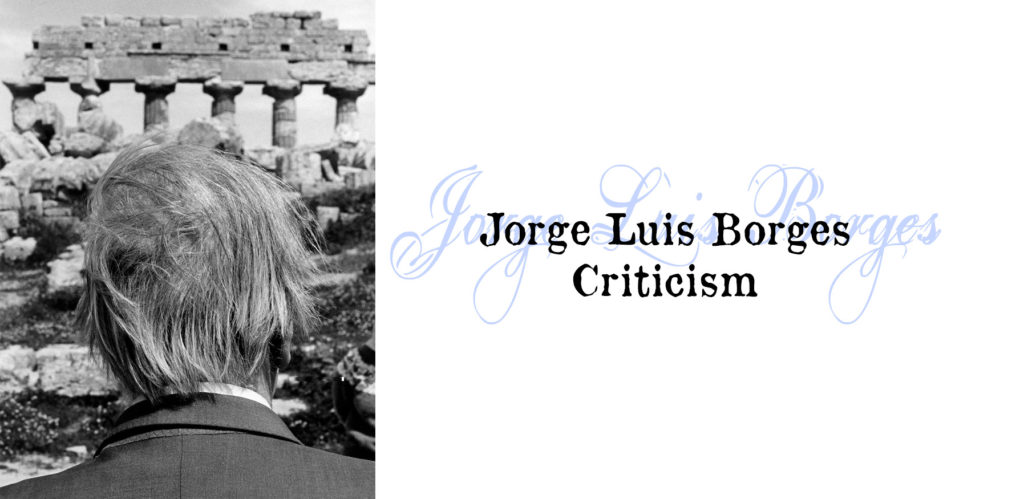Borges Criticism – General 1987 to 1999
- At August 22, 2019
- By Great Quail
- In Borges
 0
0
It is venturesome to think that a coordination of words (philosophies are nothing more than that) can resemble the universe very much.
—Jorge Luis Borges, “The Avatars of the Tortoise”
Borges Criticism: General Criticism 1987–1999
This page collects literary criticism written about Borges in the immediate years following his death. All of these works are available in English, and focus on “general criticism” such as surveys, compendiums and correspondences, conference proceedings, traditional literary analysis, and so on. (A complete list of Borges Criticism can be accessed at the bottom of the page.) The books are listed in chronological order of publication. Clicking the image of a book takes you directly to Amazon.com. Wherever possible, links to the Internet Archive are provided. These “online editions” may or may not match the exact edition of the corresponding book.
Each book contains a brief description and a summary of its contents. Some have also been reviewed. If any knowledgable visitor would like to submit comments for any of the “unreviewed” works, please contact the Garden!
The Emperor’s Kites
A Morphology of Borges’ Tales
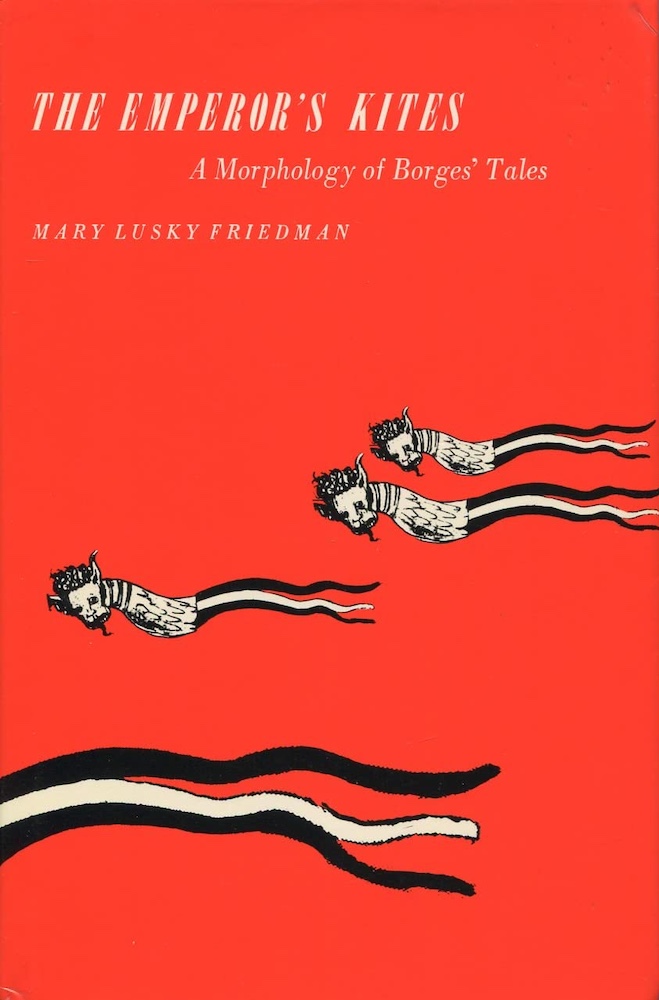
The Emperor’s Kites: A Morphology of Borges’ Tales
Friedman, Mary Lusky
Duke University Press, 1987
Online at: Internet Archive
Mary Lusky Friedman is professor of Spanish at Wake Forest University. In 1981, she was awarded a grant to study Borges’ early pieces of journalism in Buenos Aires. Eventually this research led to a deeper understanding of Borges’ development as a writer, which Friedman frames as an Oedipal conflict between Borges and his father.
Table of Contents:
Preface
Acknowledgements
Notes on Translations and Documentation
I. The Borgean Paradigm
II. Origins of the Paradigm: A Universal History of Infamy
III. Origins of the Paradigm: Irreality
IV. Mourning: A Catalyst of Genius?
Notes
Bibliography
Index
Reviews: Evelyn Fishburn’s review of The Emperor’s Kites was published in Revista Canadiense de Estudios Hispánicos, Vol. 14, No. 3 (Spring 1990): pp. 633–635, [JSTOR paywall]. One of the co-authors of A Dictionary of Borges, Fishburn praises Friedman’s work, but maintains some reservations about her thesis:
This illuminating study of Borges’ fiction is based on two premises: the first, that the entire corpus of Borges’ fiction, from the comparatively simple tales of A Universal History of Infamy to his last renderings in The Book of Sand can be seen as variations upon a basic narrative or ur-text and the second that this ur-text is essentially a story of oedipal strife. This contention is linked to the change that occurred at the time of his father’s death, in Borges’ career as a writer. I must confess that the prospect of a study combining a morphological and psychoanalytical approach filled me with misgivings of crude reductionism, but happily these fears have been proved unfounded. Prof. Lusky’s analysis is not only original and ingenious, but offers specific readings of exceptional insight. The basic plot-beneath-the plot is neatly summarized by the author: “a mishap which sets in motion a protagonist, who responds to the calamity by setting out on a journey. In the course of this journey Borges’ hero travels through surroundings that are progressively more impoverished and irreal until at last he arrives at a structure that walls him in. Immured there, he is privy to a marvellous but blighting experience, an experience that blasts his selfhood and annihilates him.” Each component of the paradigm is imaginatively established, with supporting tables of recurring motifs and imagery and with surprisingly little sense of overstrain or manipulation. The initial mishap that spurs the action of the story can be, variously, the outbreak of a fire, the purloining of something valuable, or the death of a character. The impoverishing journey mostly consists of a search whose object can be a person, a mysterious country (Uqbar), some document, and enigmatic truth; on the other hand, it may involve getting rid of a possession, such as the coin in the Zahir or the woman who is the object of love and hate in “The Intruder.” […] The suggestion is that these stories are the manifest renderings of an obsessive, latent conflict between Borges and his father.
[…] The last chapter, entitled “Mourning” attempts to explain the radical change that occurred in the quality of Borges’ writings at around 1939, with the publication of “Pierre Menard, autor del Quijote” a few months after the death of his father the previous year. The sense of two-dimensional irreality noted above and which pervaded the stories of A Universal History of Infamy gave way to the more complex, metaphysical irreality of his later masterpieces. It does not seem very novel to highlight this new dawn in Borges’ fiction writing: Borges has explained it as the result of having been at death’s door; critics, such as Matamoro and Rodríguez Monegal have attributed it to feelings of liberation from his father’s tutelage. But Lusky goes further in seeing Borges’ relationship with his father as the one obsessive inspiration in his work. She argues that the original paradigm, which had evolved around a basic motif of oedipal strife, was now re-enacted and reworked in every story with unconstrained creative power so that “the mourning process itself may have helped to catalyze Borges’ transformation into a fiction writer of genius.” The presentation of a classical Oedipal situation of filial strife is irrefutable in the way that very general comments tend to be; as Borges said Hume said of Berkeley’s arguments, “no admiten la menor réplica y no producen la menor convicción.” This is in no way to imply that they are valueless and as far as The Emperor’s Kites is concerned one may perhaps fail to be fully persuaded by the main argument proffered, but the general reading model and the close textual analysis of individual stories remain an important contribution to the interpretation of Borges’ work.
Friedman’s book has been widely reviewed. Lillian Manzor-Coats’ review appeared in the Latin American Literary Review, Vol. 16, No. 32 (July–Dec. 1988): pp. 115–117, [JSTOR paywall]. Pamela Finnegan’s review was published in Modern Fiction Studies, Vol. 34, No. 2 (Summer 1988): pp. 263–267, [Project MUSE paywall]. George Shivers’ review appeared in Revista de Estudios Hispánicos, Vol. 22, Issue 3 (Oct 1988): pg. 131, [ProQuest paywall]. Donald Leslie Shaw’s review was published in the Bulletin of Hispanic Studies, Vol. 66, No. 1 (1989), [Liverpool University Press paywall].
In Memory of Borges
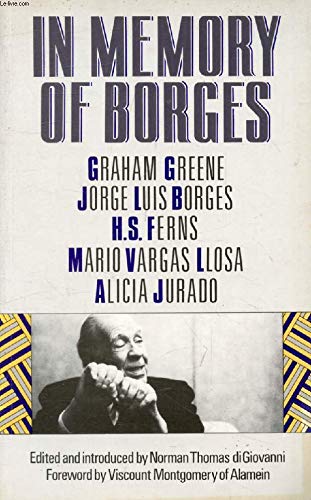
In Memory of Borges
Edited by Norman Thomas di Giovanni
Constable, 1988
Publisher’s Description: The Anglo-Argentine Society’s annual Jorge Luis Borges lectures were inaugurated in 1983, with Borges himself delivering the opening talk. The first set, collected in 1988 under the title In Memory of Borges, contained work by Graham Greene and Mario Vargas Llosa.
The Meaning of Experience in the Prose of Jorge Luis Borges
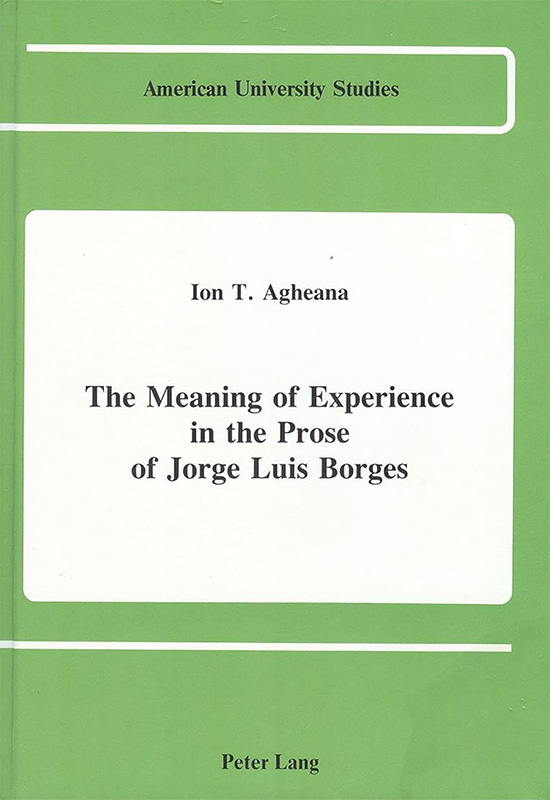
The Meaning of Experience in the Prose of Jorge Luis Borges
By Ion T. Agheana
Peter Lang, 1988
Born in Romania, Ion T. Agheana (1937-2018) was a professor of Romance Languages at Dartmouth, and later Hope College. His two areas of specialty were Jorge Luis Borges and the Romanian philosopher Emil Ciora. Also known by the even-catchier title of “American University Studies, Series II: Romance Languages and Literature, Vol. 71, The Meaning of Experience in the Prose of Jorge Luis Borges,” Agheana’s book refutes the common assertion that Borges’ fictions are more about “ideas” than “character.”
Publisher’s Description: The absence of metonymical emphasis in Borges’ prose, of the “realism” promoted by nineteenth-century writers, and the vaguely nihilistic tenor of twentieth-century philosophy, have contributed to the opinion that the Borgesian character is, at best, a spectral presence. To negate the individual, however, is to negate the vital experience that gives him identity, and Borges, arguably, does not deny human experience. The Borgesian protagonist is not really incomplete, only projected and perceived incompletely. Lived experience informs Borges’ prose fiction, and is indeed central to his critical readings of the great masters. Even the reader’s own visual experience—particularly chromatic perception—is subtly alerted and drawn into some of Borges’ prose writings.
Reviews: Julie Jones’ review of The Meaning of Experience in the Prose of Jorge Luis Borges was published in South Central Review, Vol. 6, No. 4 (Winter 1989): pp. 120–121, [JSTOR Paywall]. She found the book “poorly reasoned. In addition, its prose is often turgid and occasionally incoherent. He does not have a very good sense of English diction, and he is fond of convoluted sentences.” Mary Rice’s review appeared in Hispania, Vol. 73, No. 1 (March 1990): pp. 104–105, [JSTOR paywall]. Finding the book more intelligible than Jones, she concludes, “Despite the need for a stronger focus, Agheana’s study provides a unique and insightful critical approach.” Donald Leslie Shaw’s review was published in the Bulletin of Hispanic Studies, Vol. 67, No 3 (1990), [ProQuest paywall].
A Dictionary of Borges
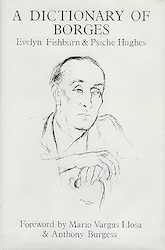
A Dictionary of Borges
By Evelyn Fishburn & Psiche Hughes
Foreword by Mario Vargas Llosa & Anthony Burgess
Duckworth, 1990
Online at: Internet Archive | Borges Center [PDF]
Evelyn Fishburn and Psiche Hughes are professors at the University College of London. They specialize in Latin American culture, feminist literature, and the arts. In 1990 they compiled A Dictionary of Borges, featuring entries on the “names of, or allusions to, personal or fictional characters, places, titles, quotations, and philosophical and religious movements” in Borges’ work. The entries are arranged alphabetically and indexed by appearance in his oeuvre. The Dictionary boasts a pair of forewords written by Anthony Burgess and Mario Vargas Llosa. The book is thorough and well-researched, and makes fascinating reading all on its own. One is reminded of Borges’ fondness for paging through encyclopedias, and in some ways Fishburn and Hughes’ project is like a Borges mixed tape—just flip to a random page, and you’re sure to discover some delightfully esoteric surprise!
Publisher’s Description: There are more than 1200 entries in all, from Alexander of Aphrodisias to Zarathustra; every relevant subject is treated, from Classical and Icelandic folklore to Chinese etiquette and the heresies of Gnosticism. Textual references are to the English and American versions and also to the Spanish originals. Dr Fishburn and Dr Hughes, both specialists in Borgesian studies, have produced an admirably concise work of reference which makes accessible to the general reader the imaginative world of one of the most challenging writers of the modern age.
Reviews: Edna Aizenberg’s review of The Dictionary of Borges was published in Revista Hispánica Moderna, Vol. 44, Issue 1 (June 1991): pg. 160, [ProQuest paywall].
A Concordance to the Works of Jorge Luis Borges (1899-1986)
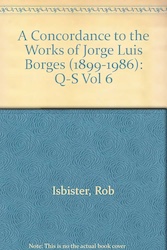
A Concordance to the Works of Jorge Luis Borges (1899-1986)
Rob Isbister & Peter Standish
Edwin Mellen Press, 1991
Compiled by Rob Isbister or Stirling University and Peter Standish of Glasgow University, this sprawling concordance to Borges’ complete works is a remarkable achievement, organized alphabetically across seven volumes. It is also prohibitively expensive, clearly designed for the libraries of academic institutions! Cristina Parodi of the Borges Center offers this summary:
Esta obra, monumental bajo varios aspectos, está destinada a especialistas interesados en cuestiones de estilo y referencias. En la concordancia se han catalogado cuatro volúmenes en prosa (Ficciones, El Aleph, El informe de Brodiey El libro de arena), de los que se registran unas 18.000 palabras en más de 125.000 apariciones; cada palabra (incluidos pronombres, preposiciones, conjunciones y artículos) está citada en su marco textual inmediato, con indicación del volumen, cuento, página y línea en que aparece en la edición de Alianza/Emecé de 1971. Como apéndice, se incluye una lista de frecuencia de palabras, que registra todos los términos con más de una aparición. El enorme esfuerzo de los compiladores ha dado por resultado una obra que tal vez -citando sus propias palabras- sea “the most boring read of the nineties”, pero que, sin duda, “will help researchers on their way to interesting things”.
Translated with some help from Google:
This work—in many ways monumental—is intended for specialists interested in styles and references. The Concordance catalogs four prose volumes (Ficciones, The Aleph, Dr. Brodie’s Report, and The Book of Sand), of which some 18,000 words are recorded in more than 125,000 appearances; each word (including pronouns, prepositions, conjunctions, and articles) is cited in its immediate textual frame, with indication of the volume, story, page, and line in which it appears in the Alliance/Emecé edition of 1971. The appendix is a list of “word frequencies,” a record of every term which occurs more than once. The enormous effort of the compilers has resulted in a work that perhaps—quoting their own words—is “the most boring read of the nineties,” but that, without a doubt, “will help researchers on their way to interesting things.”
Borges Revisited
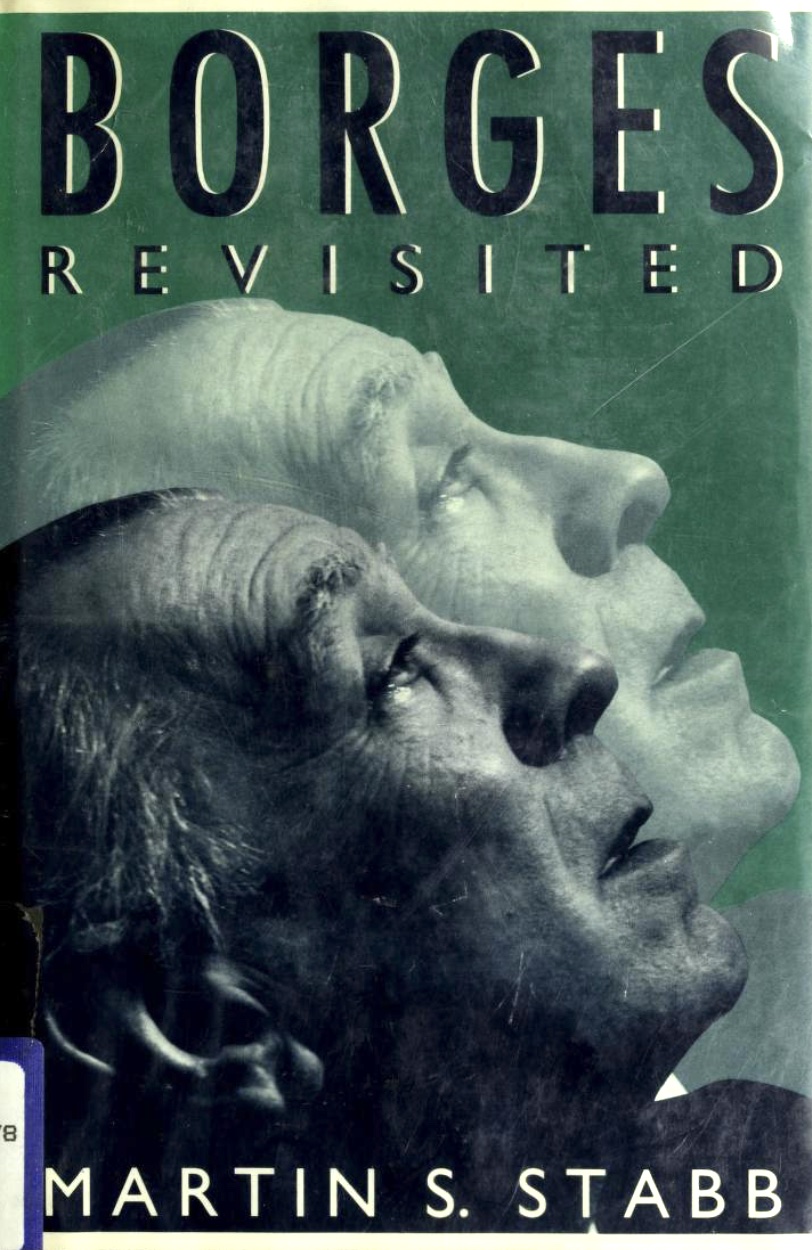
Borges Revisited
By Martin S. Stabb
Twayne Publishing, 1991
Online at: Internet Archive
Martin Stabb is a professor of Romance Languages at the Pennsylvania State University. In 1970 he wrote Jorge Luis Borges, a “student introduction” of Borges that offered a brief biography and notes on Borges’ major works. Borges Revisited is an expansion of this earlier book, a “fresh assessment of the Argentine master’s position as a major Western literary presence.”
Table of Contents:
Preface
Chronology
1. The Making of a Writer
2. The Canonical Texts
3. A Late Harvest
4. The Critical Trajectory
5. Borges In Perspective
Notes and References
Selected Bibliography
Index
Reviews: Bruno Bosteels’ review of Borges Revisited was published in the University of Pennsylvania’s Hispanic Review, Vol. 61, No. 4 (Autumn 1993): pp. 594–596, [JSTOR paywall]. The following excerpt offers a nice assessment of the book:
Both [Stabb’s] earlier and the present book are marked by the advantages and shortcomings inherent in these kinds of introductory volumes. However, this external factor should not keep the reader from asking to what degree a second visit helps him to gain a better understanding of Borges. And from a critic so thoroughly acquainted with his subject, one would have expected a more challenging synthesis.
Though fully aware of the purely “organizational value” of such divisions, Stabb orders Borges’s work into three partially overlapping “developmental phases.” The “early or formative period,” from 1923 to the 1940s, is discussed in “The Making of a Writer,” which presents Borges’s youth and family life as well as his early poetry. This first poetic phase closes with the “almost surrealistic disintegration” and tone of “ennui” reflected in some of the poems of the 1930s, suggesting “a period of transition.” While numerous quotes exemplify thematic and stylistic aspects of Fervor de Buenos Aires, Luna de enfrente, and Cuaderno San Martín, the commentaries are, however, rarely innovative. In the same chapter, Stabb also comments upon the major collections of essays. Borges “was no philosopher” for Stabb, nor can he “be viewed as a systematic literary critic,” but his miscellaneous notes or essayistic proseworks “have had a marked impact upon contemporary literary theory.” Why this is the case, however, is never really discussed; instead, the essays are merely summarized.
The second phase, which runs from the late 1930s to the early 1950s and covers the major prose texts, is studied in “The Canonical Works,” and here especially those stories from Ficciones and El Aleph not yet fully discussed in Stabb’s earlier book are analyzed in greater detail. However, Stabb’s desire to account for all stories seems to make it difficult to do more than merely restating the plot. […] The book’s interest lies mostly in the last three chapters, which transform what seemed to be another predictable introduction to Borges into a valuable guide that could provoke further investigations along similar lines of development. Chapter Three, “A Late Harvest,” studies how, after the creative hiatus of the late 50s and much of the 60s, Borges reemerges in a “remarkable renaissance.” Given that it is one of the author’s main purposes to compare the earlier to the later Borges, the book pays special attention to this third phase, consisting in a “shift away from the erudite literary gamesmanship and noonday brilliance of the canonical texts toward the more somber allegories and autumnal hues of Borges’s later period.”
In the reception of Borges—a field where “it appears that virtually everything that could be said has indeed been said”—a gap has yet to be filled. Borges’s “paradigmatic” role for the Latin American “boom,” for postmodernist fiction, and for (post)structuralist theory has not yet received the comprehensive overview it deserves. The Chapters “The Critical Trajectory” and “Borges in Perspective” offer valuable references concerning, for example, the polemics against Borges, the links with “new criticism” (a motley category that unduly includes structuralism, semiotics, and poststructuralism), and Borges’s position with respect to postmodernism and metafiction. In spite of initial promises, however, the author insists that to pursue similar lines of thought “obviously lies beyond the limits of this study.”
Students who are searching for a compact introduction will find in this book a convenient guide, written in a very pleasant, musing style (unfortunately marred by about two dozen typos). It is not the least merit of this book that the success-story of the Argentine among the “Borgephiles” has become, if not exactly interpreted, at least demonstrated and problematized. Future readers need not live “under the spell of the French critical circle—and its branch offices in places like Buenos Aires or New Haven” to appreciate the welcome opportunity which Stabb creates for further, more systematic interpretations of the Wirkungsgeschichte of Borges’s literature in twentieth-century culture.
Out of Context
Historical Reference and the Representation of Reality in Borges
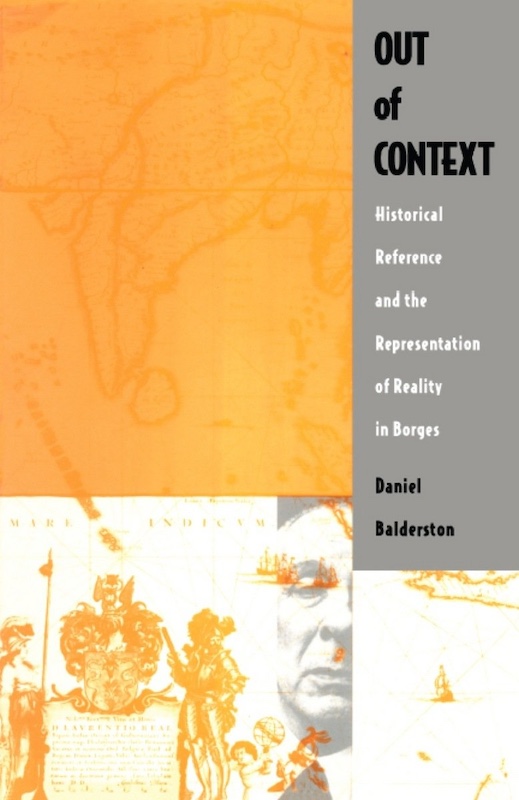
Out of Context: Historical Reference and the Representation of Reality in Borges
By Daniel Balderston
Duke University Press, 1993
A preeminent Borges scholar and literary critic, Daniel Balderston is the Mellon Professor of Modern Languages at the University of Pittsburgh. He is also the chair of the Borges Center and the editor of Variaciones Borges.
Publisher’s Description: In Jorge Luis Borges’s finely wrought, fantastic stories, so filigreed with strange allusions, critics have consistently found little to relate to the external world, to history—in short, to reality. Out of Context corrects this shortsighted view and reveals the very real basis of the Argentine master’s purported “irreality.” By providing the historical context for some of the writer’s best-loved and least understood works, this study also gives us a new sense of Borges’s place within the context of contemporary literature. Through a detailed examination of seven stories, Daniel Balderston shows how Borges’s historical and political references, so often misread as part of a literary game, actually open up a much more complex reality than the one made explicit to the reader. Working in tension with the fantastic aspects of Borges’s work, these precise references to realities outside the text illuminate relations between literature and history as well as the author’s particular understanding of both. In Borges’s perspective as it is revealed here, history emerges as an “other” only partially recoverable in narrative form. From what can be recovered, Balderston is able to clarify Borges’s position on historical episodes and trends such as colonialism, the Peronist movement, “Western culture,” militarism, and the Spanish invasion of the Americas. Informed by a wide reading of history, a sympathetic use of critical theory, and a deep understanding of Borges’s work, this iconoclastic study provides a radical new approach to one of the most celebrated and—until now—hermetic authors of our time.
Table of Contents:
- Introduction: History, Politics, and Literature in Borges
- Menard and His Contemporaries: The Arms and Letters Debate
- The “Labyrinth of Trenches without Any Plan” in “El jardín de senderos que se bifurcan”
- Prague, March 1939: Recovering the Historicity of “El milagro secreto”
- Cryptogram and Scripture: Losing Count In “La escritura del Dios”
- Going Native: Beyond Civilization and Savagery in “Historia del guerrero y de la cautiva”
- On the Threshold of Otherness: British India in “El hombre en el umbral”
- Behind Closed Doors: The Guayaquil Meeting and the Silences of History
- Conclusion
A Spanish version of Balderston’s book is available as Fuera de contexto?, Rosario: Beatriz Viterbo Editora, 1997.
Reviews: Eduardo González’s review of Out of Context was published in Latin American Literary Review, Vol. 22, No. 43 (January–June 1994): pp. 81–83, [JSTOR paywall.] González has mixed feelings about Balderston’s thesis, but finds some of his research worthwhile. A pithy and somewhat snarky review, it’s worth quoting at length:
Establishing a proper social context for Borges’s writings has been a messy political affair and very often a prelude to his symbolic beheading. Reaching context beyond fiction in his case has for the most part prompted references to what is named history, or, perhaps more accurately and less pretentiously, politics. It would take a rather long and arduous book to apply any sort of history as the primary context in which to study a writer as significant as Borges. It should take at least a careful rehearsal of how certain contexts, including history as presently privileged, become meaningful only in being applied, since stories (and their histories) are never found ready-made, whether they are recorded, overheard or interpreted. Luckily, most books on Borges are not long, at least not much longer than required by thematic agendas or by yielding or resistant readings. Critics who employ history in studying Borges’s work have until recently conceived their task as oppositional, and history itself as a force shadowing the writer’s presumed imaginative autonomy. At times, history has been tooled to bash Borges for being a petty middle-class fabulist or a fanciful reactionary in need of punishment for his perceived lack of ressentiment. Soaked in history, Borges’s text comes unglued to reveal the sentimental (and resentful) features beneath his playful aristocratic cynicism.
Daniel Balderston is guided by a friendlier purpose as he scrutinizes the textual sources presumably relevant to the writing and appreciation of six of Borges’s stories and to the genealogical sublimities inscribed in the well-wrought urn of his “Poema conjetural.” Balderston sets out to “show how an imaginative reading of Borges’s texts that is attentive to historical and political context can discover implications in those texts that considerably complicate the picture we have had up to now of the ‘postulation of reality’ in Borges.” Since complicating a picture might seem to lack much explanatory reward, Balderston qualifies the usefulness of his context-bound inquiry by rejecting the “critical consensus” that considers Borges an “escapist” writer. Whether or not Balderston is correct in seeing a non-escapist where others might see a skillful escape artist, he moves against the grain of consensus in Borges studies and proceeds to package his chosen stories in a thick tissue (often bewildering but mostly illuminating) of circumstantial reference. Balderston also sees himself going against “high structuralism,” as “it existed in universities in the United States,” where it “emphasized self-referentiality, the fantastic, the web of intertextual (but always literary) reference.” It might seem unfair (and perhaps biased by a bit of guilt) for a true-blue Princeton Borges expert to blame such post structuralist readings exclusively on university critics operating from imperial sites. After all, the turn toward historicizing so earnestly honored by Balderston is as American as apple pie. It was crafted (as New Historicism) mainly at Berkeley and largely in response to untrammelled imported deconstruction during the early years of Reagan’s long reign by a handful of gifted practitioners, such as Stephan Greenblatt, Walter Michaels and Michael Paul Rogin, whose Subversive Genealogy: The Politics and Art of Herman Melville (1983) strikes me as the best prototype of the bold political character that context-building intellectual and literary histories ought to possess.
In his belated efforts to “historicize Borges’s works,” Balderston wishes to accrue “a certain polemical force,” since, in his view, “history still constitutes a scandal for literary theory: something irreducibly beyond the text,” although, he adds, invoking “Jameson,” that this same history “may be accessible to us only through texts.” Nevertheless, as I see it, part of the scandal boils down to the increasingly burdensome historicist imperative of having to qualify and put in context references such as “Jameson” and “us.” Otherwise the rather dubious chance of any scandal would arise from avoiding historicist qualifiers of whatever length or complexity. In any event, I see Balderston seeking acrobatic footing, pretzel-style, on disparate tendencies in textual interpretation, as when he says that the “scandal that history constitutes for literature (or narrative fiction—and theory—constitute for history, as in the work of Hayden White) is rather like the scandal that the notion of material reality causes the philosophers of Tlön.” As the reference to White (who brilliantly stresses fictiveness and rhetorical play in narrative histories) should imply, underneath this fervor for historicized matter, Balderston remains a Tlönian at heart. He evokes the imperial surveyor, who advocates the authority of the unearthed historical stuff forever embedded in each examined story which he painstakingly turns into an eternal record. Such sold stuff is the context, developed by Balderston within a space bookish reference presumably immune from the ravages of time.
Anyone seriously involved in teaching or interpreting the works examined in Out of Context would be wise to ponder the wealth of detail it deploys and the constraints it claims to establish in reference to further imaginative dealings with Borges’s fictions. Although I found the chapter on Pierre Menard rambling and pedantic, all the others proved rewarding, the most impressive being those on “El milagro secreto,” “Historia del guerrero y de la cautiva” and “El hombre en el umbral,” in which Balderston’s copious findings of relevant sources within and without Borges yield precious insights. I also felt inspired and yet tortured by “Cryptogram and Scripture: Losing count in ‘la escritura del dios’,” where Balderston might have offered (in his style of peerless concreteness) a view of Borges’s sublime masking of sexual masochism (memorably phrased in “Ecstasy does not repeat its symbols,” but where he offers instead a christological reading of the priest narrator’s predicament in the story. But such are the pains found in (and our?) of context.
Amelia Barili’s review appeared in Revista de Crítica Literaria Latinoamericana, Vol. 21, Issue 42 (Fall 1995): pg. 267, [ProQuest paywall]. Horacio Xaubet’s review was published in Revista de Estudios Hispánico, Vol. 32, Issue 2 (May 1998): pg. 417, [ProQuest paywall].
Jorge Luis Borges
A Writer on the Edge
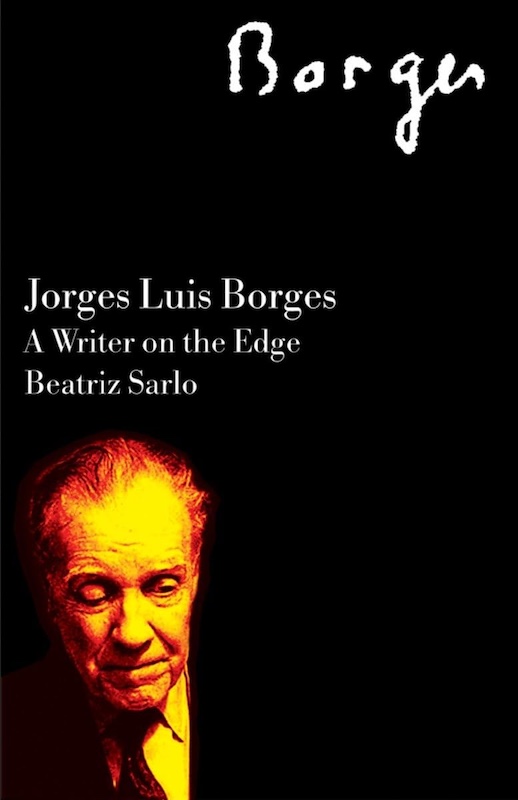
Jorge Luis Borges: A Writer on the Edge
By Beatriz Sarlo
Verso, 1993
Online at: Internet Archive | Borges Center
Born in Buenos Aires in 1942, Beatriz Sarlo is one of Argentina’s most prominent literary, cultural, and social critics, a renown public intellectual and founder of several magazines. Widely recognized as one of the most influential books about Borges, A Writer on the Edge was developed from a series of lectures Sarlo delivered at Cambridge University.
From Library Journal:
Drawing both from textual analysis and Borges’s Buenos Aires literary circles, Sarlo challenges—and deftly refutes—the conventionally held proposition that “Borges’s reputation in the world has cleansed him of nationality.” She then successfully demonstrates that Borges lived and wrote in a richly diverse, cosmopolitan milieu with dual Argentine-European roots. Even in his most fantastic, problematic fiction (best exemplified in the three stories “Tlön, Uqbar, Orbis Tertius,” “The Library of Babel,” and “The Lottery in Babylon”), Borges is shown to address real social and philosophical questions of the day.
Table of Contents:
Introduction
Chapter 1: A Landscape for Borges
Chapter 2: Borges and Argentine Literature
Chapter 3: Tradition and Conflicts
Chapter 4: Tropes of Fantastic Literature
Chapter 5: Imaginary Constructions
Chapter 6: A Question of Order
Chapter 7: The Adventure of Martín Fierro: The Avant-Garde & Criollismo
Chapter 8: Utopia & the Avant-Garde
Appendix: Borges and the Little Magazines in the 1920s
Bibliography
Reviews: Marcy E. Schwartz’s review of Jorge Luis Borges: A Writer on the Edge was published in Modern Language Notes, Vol. 110, No. 2 (March 1995): pp. 457–459, [Project Muse paywall]. The following excerpt offers a good explanation of Sarlo’s thesis:
Sarlo’s first book in English combines intellectual history with close readings to restore to Borges’s work what she claims has been lost in a critical “process of triumphant universalization.” Jorge Luis Borges: A Writer on the Edge reexamines Borges in the context of Argentine thought, letters, history and politics. Sarlo draws from her earlier work on the intellectual history of Buenos Aires (in particular Una modernidad periférica: Buenos Aires 1920 y 1930, Buenos Aires, Nueva Visión, 1988), and from lectures given at Cambridge University in 1992. The chapters discuss Borges’s poetry, short stories and essays as well as his participation in cultural projects such as the Ultraísta movement and the avant-garde journals Martín Fierro and Proa. Sarlo approaches Borges from a Marxist, cultural studies perspective, directly responding to what she calls the leftist “suspicion” of Borges. She links Borges’s personalized version of Argentine tradition and fantastic fiction to moral as well as esthetic responses to a historical moment.
Sarlo’s study complements and corrects the overwhelming tendency of scholarship on Borges that categorizes him as a cosmopolitan writer whose national tradition is an incidental rather than a decisive element in his writing (i.e., Michel Berveiller, Le Cosmopolitisme de Borges, Paris, Didier, 1973). Sarlo reestablishes Borges as a paradoxically regional writer: he is an urban elite cultural figure on the margins of both European and Latin American canonical esthetic movements. She focusses on Borges’s early poetry, his study of Evaristo Carriego, and gauchesque themes in his fiction to reveal the overlooked regional and local issues that occupy much of his work. Her study examines Borges’s work as the product of a cultural identity crisis, and situates specific texts in the cultural and political context of their time.
An earlier review by Amelia Barili appeared in Revista de Crítica Literaria Latinoamericana, Vol. 20, Issue 40 (Fall 1994): pg. 388, [ProQuest paywall].
The Borges Tradition
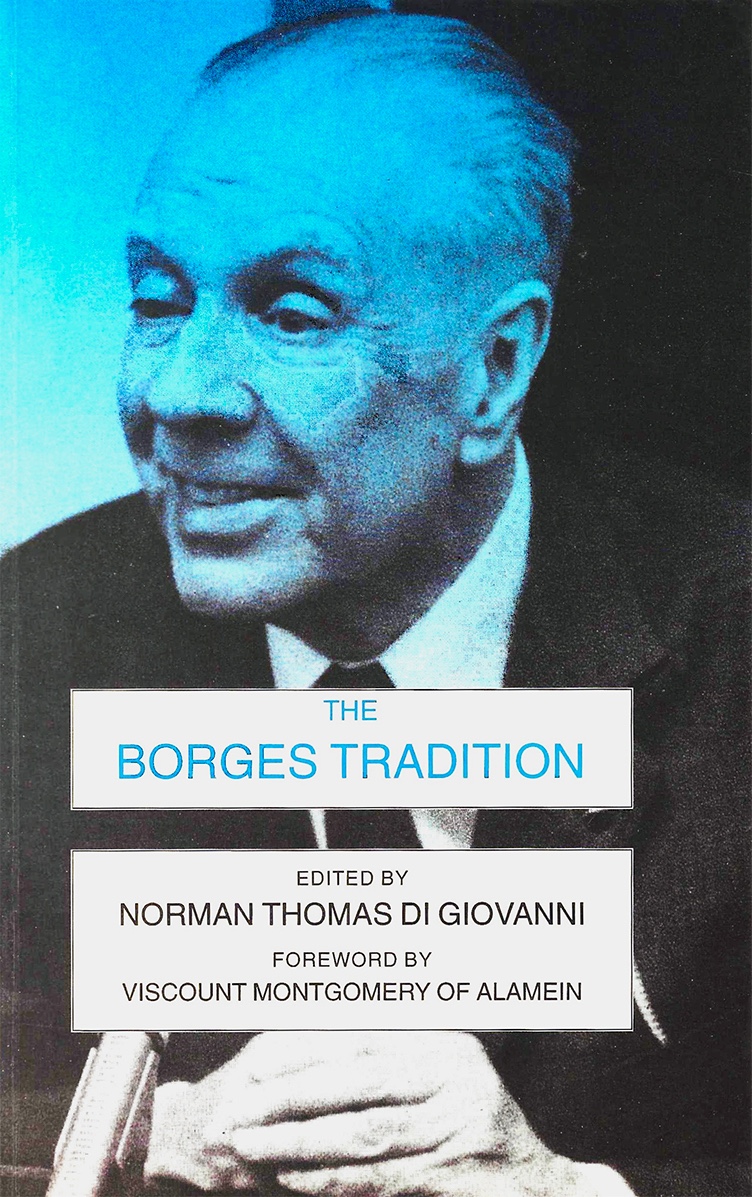
The Borges Tradition
Edited by Norman Thomas di Giovanni
Constable, 1995
Publisher’s Description: The Anglo-Argentine Society’s annual Jorge Luis Borges lectures were inaugurated in 1983, with Borges himself delivering the opening talk. The first set, collected in 1988 under the title In Memory of Borges, also contained work by Graham Greene and Mario Vargas Llosa. The Borges Tradition, which includes essays by both imaginative writers and scholars, collects the lectures given from 1988 to 1993. The volume treats us to the subversive humour of Cuban-British novelist Guillermo Cabrera Infante; the late Angela Carter detailing Borges’s imaginary zoo; Mexican writer Carlos Fuentes describing his early formative years in Buenos Aires; Simon Collier marking the 150th anniversary of the birth of W.H. Hudson; and the celebrated Argentine novelist, Adolfo Bioy-Casares, Borges’s long-time friend and collaborator, holding an informal conversation with his audience. Appendices include an important essay by Adolfo Bioy-Casares on his work with Borges and a checklist, compiled by Jason Wilson, of Argentine literature published in English between 1988 and 1993.
Table of Contents:
Foreword by Viscount Montgomery of Alamein
Introduction by Norman Thomas di Giovanni
Guillermo Cabrera Infante, “My Dinner with Borges”
Angela Carter, “Borges the Taxonomist”
Carlos Fuentes, “The Accidents of Time”
Simon Collier, “The Four Worlds of W.H. Hudson”
Adolfo Bioy Casares, “An Evening with Bioy”
Appendices:
Adolfo Bioy Casares, “Books and Friendship”
Jason Wilson, “Argentine Literature in English 1988–93, An Annotated Checklist”
Notes on Contributors
Borges and Europe Revisited
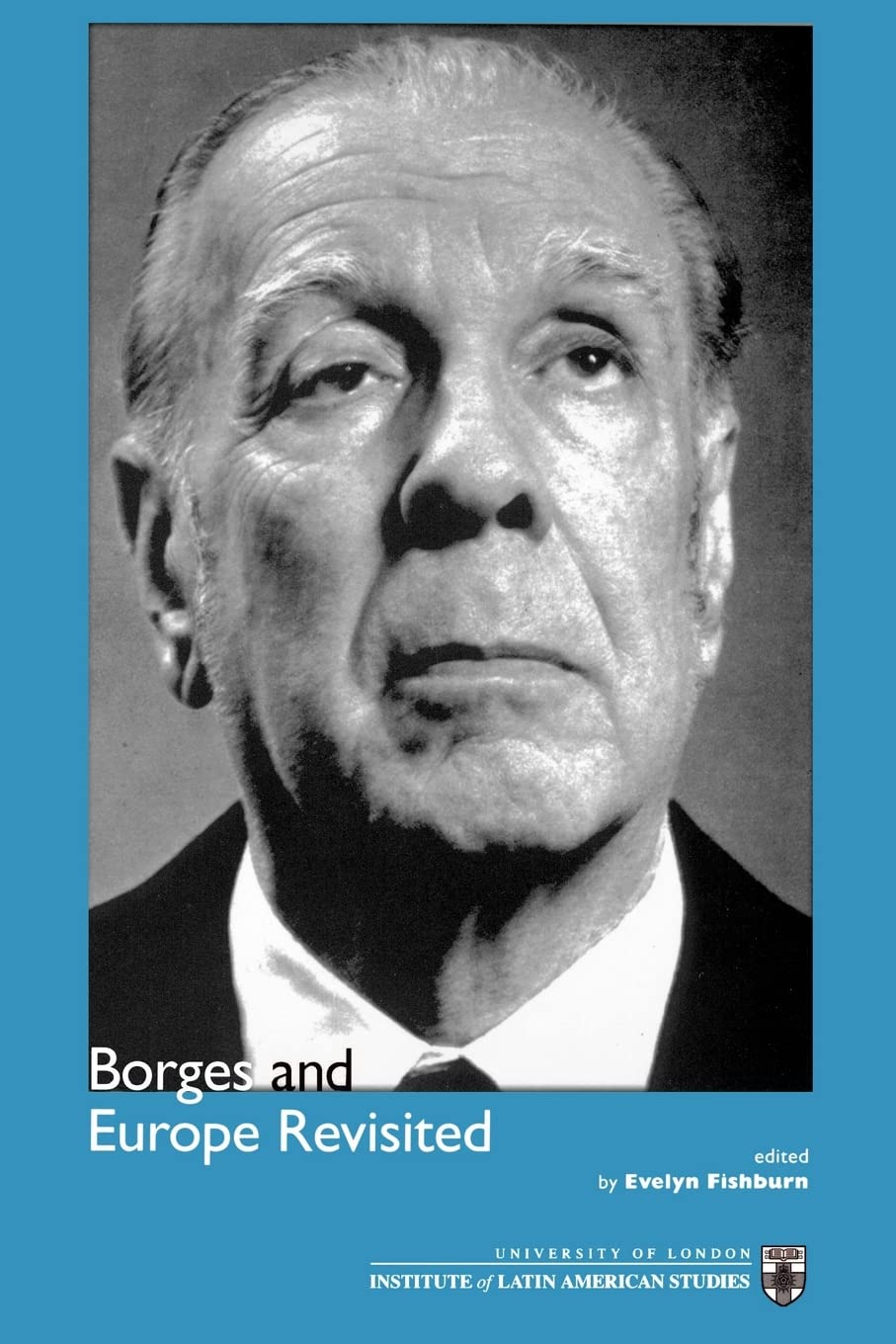
Borges and Europe Revisited
Edited by Evelyn Fishburn
Institute of Latin American Studies, 1998
Online at: Internet Archive
In 1996 a one-day Borges conference was held at the University of North London. This book collects, edits, and organizes many of the papers that were presented.
Publisher’s Description: This compilation of essays takes a fresh look at Borges’s work. A wide variety of topics, ranging from the European avant-garde to the impact of European science upon Argentine literature, is discussed from a multiplicity of angles—the only unifying factor being the year 1996, when nearly all the essays were written. Most of them were presented as papers at a one-day conference held at the Institute of Romance Studies, in conjunction with the Institute of Latin American Studies. The purpose was to re-examine the work of Borges in the wake of the great changes in reading that “theory” had brought about and which Borges had somehow foreshadowed, though of course not systematized.
Table of Contents:
- Introduction by Evelyn Fishburn
- Sylvia Molloy, “Lost in Translation: Borges, the Western Tradition and Fictions of Latin America”
- William Rowe, “How European Is It?”
- Daniel Balderston, “Borges: The Argentine Writer and the ‘Western’ Tradition”
- Evelyn Fishburn, “Hidden Pleasures in Borges’ Allusions”
- Gabriel Josipovici, “Borges and the Plain Sense of Things”
- Jason Wilson, “Jorge Luis Borges and the European Avant-Garde”
- Bernard McGuirk, “Falklands/Malvinas and Excess: On Simultaneous TransNation and the Poetry of War”
- Eduardo L. Ortiz, “The Transmission of Science from Europe to Argentina and its Impact on Literature: from Lugones to Borges”
- Malcolm Bowie, “Afterword: Borges and the Art of Illusion”
Reviews: Herbert J. Brant’s review of Borges and Europe Revisited was published in Revista Canadiense de Estudios Hispánicos, Vol. 25, No. 2 (Winter 2001): pp. 332–334, [JSTOR paywall]. Grant concludes that “In spite of these two exceptional essays [Molly and McGuirk], the overall effect of the volume is rather weak. In addition to its unevenness in terms of ‘freshness’ and critical innovation, and, indeed, the level of sophistication of the essays in this collection, the lack of a more comprehensive, thought-provoking introduction to the volume is a further disappointment for the reader.”
Borges, la pasión de una cita sin fin
Borges: The Passion of an Endless Quotation
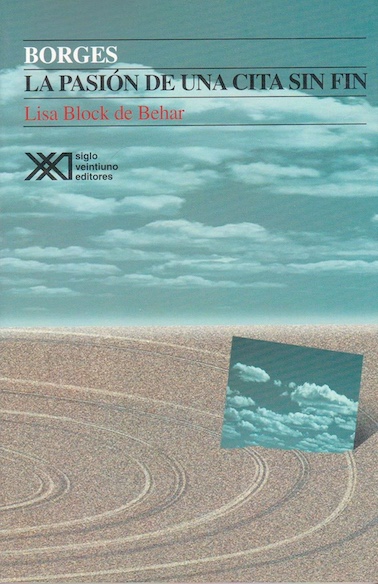 Borges, la pasíon de una cita sin fin By Lisa Block de Behar Mexico: Siglo XXI Editores, 1999 |
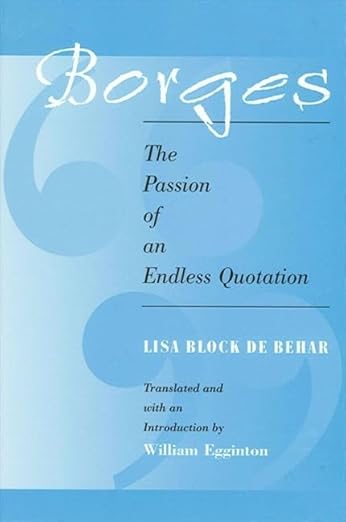 Borges: The Passion of an Endless Quotation [First Edition] By Lisa Block de Behar Translation by William Egginton SUNY Press, 2002 |
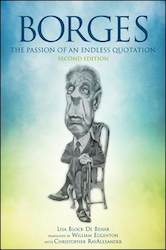 Borges: The Passion of an Endless Quotation [Second Edition] By Lisa Block de Behar Translation by William Egginton SUNY Press, 2014 Online at: Internet Archive |
Lisa Block de Behar is Professor of Communications at the Universidad de la República in Montevideo. She published Borges, la pasión de una cite sin fin in 1999. It was translated into English by William Egginton in 2002 and published by the State University of New York Press in Albany. Twelve years later a second, expanded edition was released.
Publisher’s Description: Borges cites innumerable authors in the pages making up his life’s work, and innumerable authors have cited and continue to cite him. More than a figure, then, the quotation is an integral part of the fabric of his writing, a fabric made anew by each reading and each re-citation it undergoes, in the never-ending throes of a work-in-progress. Block de Behar makes of this reading a plea for the very art of communication; a practice that takes community not in the totalized and totalizable soil of pre-established definitions or essences, but on the ineluctable repetitions that constitute language as such, and that guarantee the expansiveness—through etymological coincidences of meaning, through historical contagions, through translinguistic sharings of particular experiences—of a certain index of universality. This edition includes a new introduction by the author and three entirely new chapters, as well as updated images and corrections to the original translation.
Table of Contents: The 2014 book contains a new Author’s Introduction and reprints the Translator’s Introduction from the first edition. There are 14 chapters:
- First Words
- Variations on a Letter avant-la-lettre
- Paradoxa Ortodoxa
- On “Ultrarealism”: Borges and Bioy Casares (The Interlacing of Imagination and Memory on the Thresholds of Other Worlds)
- Borges and García Márquez: On How to Put Life Into Words, and How to Recount Them
- A Complexly Woven Plot: Borges, Bioy Casares, Blanqui (Conjectures and Conjunctions at the Limits of Possible Worlds)
- Theoretical Invention in Fiction: Marvels, Miracles, and the Gazes of Miranda
- The Ironies of a Blind Sect
- Symbols and the Search for Unity
- The Paradoxes of Paradoxes
- Vox in Deserto: Borges and the History of Sand
- The Imagination of Knowledge
- The Place of the Library
- Fiction Between Fraud and Farce: Parodies and Properties of the Name
Borges Criticism
Main Page — Return to the Borges Criticism main page and index.
General Criticism 1 — General literary criticism and commentary written during Borges’ life, 1957–1986.
General Criticism 3 — General literary criticism and commentary written from 2000 to the present.
Poetics — Criticism written about Borges’ poetry and poetics.
Comparative Criticism — Borges criticism that compares Borges with other writers or locates Borges’ work within a broader literary context such as genre fiction or Latin American Literature.
Political & Theoretical Criticism — Borges criticism with a strong political, theoretical, or philosophical component: Marxist critique, postmodernism, postcolonial studies, gender studies, queer theory, disability studies, etc.
Religious & Esoteric Criticism — Borges criticism from a religious, metaphysical, or esoteric perspective.
Scientific Criticism — Borges criticism within the disciplines of science, mathematics, and technology.
Author: Allen B. Ruch
Last Modified: 23 August 2024
Main Borges Page: The Garden of Forking Paths
Contact: quail(at)shipwrecklibrary(dot)com

